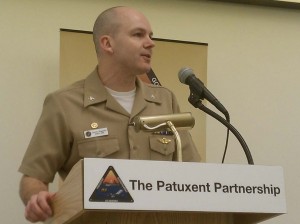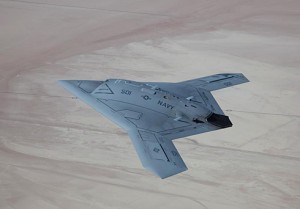Carrier Drone Ramping Up

By Jay Friess
Editor
Capt. Jaime Engdahl, program manager for the Unmanned Combat Air Systems program office (PMA-268), did not want to talk Wednesday about things his program’s X-47B bat-winged drones might eventually do, like drop bombs on the Navy’s enemies.
He tried to wave off questions about the X-47B’s eventual capabilities at a briefing sponsored by The Patuxent Partnership at the Southern Maryland Higher Education Center. But when asked about weaponizing the platform, he said, “No mission systems work or weaponization work will be done on this program.”
The program’s job is hard enough. “First, we have to get aboard the ship,” Engdahl said. “We’ve talking about automating simple tasks that a pilot does in a carrier environment.”
These “simple” tasks include completing a catapult launch, landing on the pitching deck of an aircraft carrier and completing mid-air refueling. So far, the program has completed 16 flights at Naval Air Station Patuxent River, clearing the X-47B to fly as high as 15,000 feet and as fast as 200 knots. Those numbers will likely increase as the program progresses.
The program will now move on to testing the aircraft on Pax River’s precision approach equipment, catapult and arresting wires to adjust it for carrier trials aboard the USS Dwight D. Eisenhower next year.
“This is the one place in the world where we have all these capabilities,” Engdahl said.
During the tests, Engdahl said the aircraft will be visible from the base, Solomons Island and occasionally Point Lookout. The tests, he said, will take place “always over the water and always specifically controlled.”
Engdahl said the X-47B “pre-programmed to do very specific things” if it loses contact with all three of its radio control links and will try to return to Pax River. “It will be chased at all times,” Engdahl said, noting that a manned aircraft will follow it during tests. He said the program will not test intentionally breaking contact with the aircraft.
“We will not be doing lost comm contingency testing in the air,” Engdahl said.
The program also expects to take delivery of a second X-47B aircraft this spring, which is scheduled to be taken aboard a carrier this fall to test how it will be practically handled on the flight deck.
As for what happens to the X-47B after the UCAS program’s testing regime is done, Engdahl declined to comment. Engdahl was asked if Deputy Defense Secretary Ashton Carter’s visit to Pax River last week was to see if the X-47B could be fielded for reconnaissance and light strike duty by 2015. Engdahl chose his words carefully.
“There was no discussion at that time about what you mentioned,” he said.

























